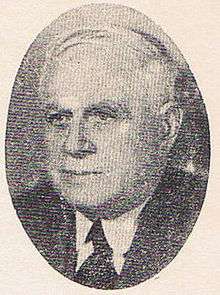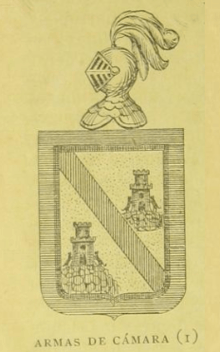Nicolás Camára Vales
Nicolás Cámara Vales (1875 — 1956) was a Mexican liberal politician, diplomat and paediatrician who served as Governor of Yucatán on two occasions between 1911 and 1913; after the military putsch known as the Ten Tragic Days, he was forced to resign and go into exile. Having studied medicine in the University of Berlin, he spoke fluent German and during the 1920s, he served as a diplomat stationed in Berlin and Vienna. Having founded the Henequen Regulatory Commission, he later served as its Chairman.[1]
Nicolás Cámara Vales | |
|---|---|
 | |
| Governor of Yucatán | |
| In office 1912–1913 | |
| Preceded by | Agustín Patrón Correa |
| Succeeded by | Fernando Solís León |
| Governor of Yucatán | |
| In office 1911–1911 | |
| Preceded by | José María Pino Suárez |
| Succeeded by | Agustín Patrón Correa |
| Personal details | |
| Born | 1875 Mérida, Yucatán, Mexico |
| Died | 1956 (aged 81) Mexico City, Mexico |
| Nationality | Mexican |
| Political party | Progressive Constitutionalist Party |
| Spouse(s) | Joaquina Millet Heredia |
| Children | Berta Nicolás Jorge |
| Parents | María del Carmen Vales Castillo (mother) Raymundo Cámara Luján (father) |
| Relatives | María Cámara Vales (sister) José María Pino Suárez (brother-in-law) Alfredo Cámara Vales (brother) Alfredo Pino Cámara (nephew) Pablo Castellanos Cámara (nephew) Ismael Moreno Pino (grandnephew) |
| Residence | Mérida, Yucatán |
| Alma mater | University of Berlin (M.D) |
| Occupation | Pediatrician, politician and diplomat |
| Profession | Doctor of Medicine |
Family and Education

Born in Mérida, Yucatán on the 25th April 1875, the eldest son of Raymundo Cámara Luján (1850-1919), a wealthy hacienda owner and industrialist who made a fortune during the henequen boom, and María del Vales Castillo (1855-1936)[2]. His maternal uncle was Agustín Vales Castillo, a Yucatecan industrialist and banker who served as the Political Head of Mérida during the latter half of the 19th Century.
His paternal family was an old patrician family, which could claim descent from several of the Spaniards who had participated in Spanish Conquest of Yucatán; amongst these, he was an direct line descendant of Juan de la Cámara, the Spanish conquistador and nobleman who had been on the founders of Mérida in 1542. He was also a descendant of Francisco de Montejo.
The eldest of thirteen siblings, the Cámara Vales brothers were educated in a household which emphasised liberal values and a European education with a strong emphasis on music and foreign languages; he played the violin and piano and spoke fluent English, Spanish, French and German.
He earned a Doctor of Medicine degree at the University of Berlin in Germany, graduating with the thesis "The Pellagra in Yucatán" (1896).[3][4][5] Having specialised in Pediatrics, he returned to Mérida and opened the first children's clinic in the Yucatan penninsula.
He married Joaquina Millet Heredia. She was the daughter of José María Millet Hübbe, a prosperous businessman of French, German and Danish origin, and Joaquina Heredia Cacaño. The couple had two sons and a daughter: [6]
- Berta Cámara Millet
- Nicolás Cámara Millet
- Jorge Carlos Cámara Millet
Several members of his close family have contributed to Mexican society:
- María Cámara Vales, his sister, served as Second Lady of Mexico and earned the Belisario Domínguez Medal of Honor in 1969[7].
- José María Pino Suárez, his brother-in-law, served as Vice President of Mexico and was also the former Governor of Yucatán, President of the Senate, Secretary of State Education and the Fine Arts and also served as Secretary of State for Justice in Madero's provisional government.
- Alfredo Cámara Vales, his brother, served as Governor of the Federal Territory of Quintana Roo.
- Alfredo Pino Cámara, his nephew, was a distinguished jurist who served a Chief Justice of the State of Zacatecas and was the judge responsible for instructing the famous murder case against Tina Modotti, the Italian communist photographer.[8][9]
- Pablo Castellanos Cámara, his nephew, was a noted concert pianist and disciple of Alfred Cortot, studying under him in Paris, France.[10]
- Ismael Moreno Pino, his grandnephew, was a lawyer and senior diplomat who served as Undersecretary of State for Multilateral Affairs at the Foreign Office and was the Mexican Ambassador to Germany and the Netherlands.[11]
Career
His liberal ideals identified him with Francisco I. Madero, a close friend of the Cámara family and of his brother-in-law, José María Pino Suárez. A militant of the National Antireelectionist Party (later named as the Progressive Constitutionalist Party), he campaigned in his native state for the Maderista cause. During the 1911 State Election, Cámara Vales was instrumental in convincing much of the Yucatecan oligarchy to transfer their allegiance to José María Pino Suárez, who won the governorship with an ample margin. The gubernatorial term of Pino Suárez was cut short, however, when he was elected to the Vice-presidency of the Republic as a result of the 1911 Federal Elections. After Pino Suárez resigned as Governor, the State Congress appointed Cámara Vales as interim Governor of Yucatan. As interim Governor, Cámara Vales organized the 1912 extraordinary elections. Deciding to stand as a candidate, he resigned to the governorship, being replaced by Agustín Patrón Correa.
After winning the 1912 gubernatorial elections, he returned to power. During his brief term as governor, his most important achievement was ordering the creation of the Henequen Regulatory Commission (Comisión Regulatoria de la Industria del Henequen). During the latter half of the 19th Century and the first years of the 20th century, the lucrative henequen industry had been the principal export of the Yucatán Peninsula. Olegario Molina Solís, a powerful former Governor, and his cronies had manipulated prices to their own advantage in detriment of other competitors. The purpose of the Commission, therefore, was to regulate the henequen industry and avoid price manipulation and other such corrupt practices.
In February 1913, General Bernardo Reyes, a disgraced former Secretary of Defence, escaped from prison and lead a group of reactionary military officers in a putsch directed against the Madero Government. The Federal Army managed to contain the rebellion to La Ciudadela (the citadelle), an old artillery fortress. General Victoriano Huerta, the newly appointed Chief of Staff of the Federal Army, was already negotiating behind the scenes with the putschist army officers and with Henry Lane Wilson, the U.S. Ambassador who was acting without having received instructions from his government. After General Huerta betrayed the Federal Government, President Madero and his entire cabinet were placed under arrest in the National Palace. The President and Vice-President was forced to resign at gunpoint and subsequently assassinated. General Huerta, meanwhile, surrounded the National Congress with his troops and had himself sworn in using a dubious legal manoeuvre.
Nicolás Cámara Vales resigned immediately in protest against the military putsch in which his brother-in-law had been assassinated and his own sister, nieces and nephews became victims of government persecution. Knowing that his own security was in question, he immediately fled the State, taking the first boat out to Havana, before settling into exile in the United States, where Maderista cause had the full backing the newly inaugurated Wilson administration. In August 1914, the Huerta dictatorship was overthrown, and the new revolutionary regime was more sympathetic to Cámara Vales, although they did not share the democratic and liberal principles of the former Governor.
After his exile, he held various positions in the Mexican diplomatic service, representing his country in Berlin[12] and Vienna[13]. Returning to Yucatan, he served as the Chairman of the Henequen Regulatory Commission.
He died in Mexico City in 1956 at the age of 81.
References
- "Leyes y Decretos de la Revolución en Yucatán". Por Esto!. Retrieved 6 July 2012.
- "Genealogía de Nicolás Cámara Vales". Geneanet (in Spanish). Retrieved 2020-05-18.
- Medicine (U.S.), National Library of; Office (U.S.), Library of the Surgeon-General's (1915). Index-catalogue of the Library of the Surgeon-General's Office, United States Army: Authors and subjects. U.S. Government Printing Office.
- Ergebnisse der allgemeinen Pathologie und pathologischen Anatomie (in German). Springer. 1915.
- Wood, Edward Jenner (1912). A Treatise on Pellagra: For the General Practitioner. D. Appleton.
- "Genealogía de Nicolás Cámara Vales". Geneanet (in Spanish). Retrieved 2020-05-18.
- "María Cámara Vales, viuda de Pino Suárez" (PDF). Jurídicas UNAM.
- Poniatowska, Elena (1992). Tinisima. Ediciones Era. p. 108.
- Albers, Patricia (2002). Shadows, Fire, Snow: The Life of Tina Modotti. University of California Press. p. 207.
- México, Escrito por: Música en México Redacción Música en México tiene la misión de promover la música clásica-y la música nueva – en; Mundo, Y. De Dar a Conocer Una Selección De Las Actividades Musicales En El Resto Del. "Pablo Castellanos Cámara, Stella Contreras". Música en México (in Spanish). Retrieved 2020-05-18.
- "Ismael Moreno Pino, embajador eminente" (PDF). Memorias de la Diplomacia Mexicana. Archived (PDF) from the original on
|archive-url=requires|archive-date=(help). - Arreola, Flora Elena Sánchez (1998). Catálogo del archivo de la Escuela Nacional de Bellas Artes, 1857-1968: Archivo Histórico del Centro de Estudios sobre la Universidad (in Spanish). UNAM. ISBN 978-968-36-6652-9.
- Bundespressedienst, Austria (1930). The Austrian Year Book. Austrian Federal Press Department.